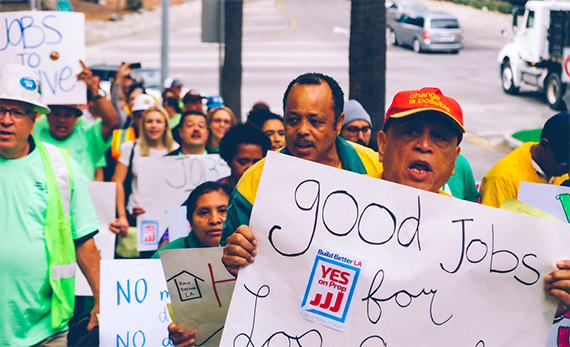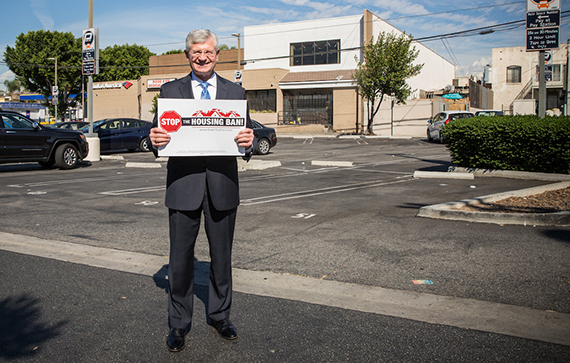Trending
Housing issues: What to expect — or dread — on the November ballot

It may be hailed as the wildest presidential election in U.S. history, but the flustering battle between Hillary Clinton and Donald Trump should not eclipse local matters come November 8. Along with statewide initiatives and Congressional races, this year’s ballot could have serious implications for housing in Los Angeles.
At least $1.2 billion and the future of almost every new development are at stake with two ballot initiatives: Measures HHH and JJJ.
HHH aims to tackle L.A.’s homelessness crisis by issuing a $1.2 billion bond, paid back by an incremental property tax increase. The money will be used to build 10,000 units of permanent supportive housing over the next decade.
Meanwhile, JJJ, also known as the Build Better L.A. initiative, would require developers to set aside between 25 and 40 percent of a project’s total units for affordable housing and pay worker prevailing wages set by the city’s Bureau of Contract Administration.
Both measures would require a two-thirds vote to pass. Read on to see who is for, against and behind each measure — and get informed before the vote.
HHH
Measure HHH addresses the issue of housing the roughly 47,000 people who are homeless in Los Angeles County — a number that Ann Sewill, vice president of housing at the California Community Foundation, said is actually understated, as it does not include the roughly 150,000 people who cycle in and out of housing each year.
Under HHH, the city would buy a $1.2 billion bond over the course of 10 years. In turn, the bond will be paid back over three decades by a roughly .01 percent increase in property taxes. It would cost homeowners an average of just under $10 a year for every $100,000 of property value.
In terms of public endorsements, Measure HHH is the more popular of the two. Flanked by city officials, including Mayor Eric Garcetti and Council President Herb Wesson, the initiative is the product of extensive debate and discussion in City Hall. The proposal was written by the leaders of the City Council’s Homelessness and Poverty Committee, Marqueece Harris-Dawson and José Huizar.
Campaign efforts have been led by the L.A. Chamber of Commerce and the anti-poverty organization United Way. To date, the measure has accrued endorsements from the L.A. Times, L.A. County Supervisor Hilda Solis, and at least seven council members.
Housing advocates, labor unions and some private developers have lauded the measure, calling it a necessary step in fighting homelessness. It is bankrolled by an array of private individuals, developers and corporations. Anschutz Entertainment Group, for instance, donated $25,000 to the campaign in September, according to Ethics Commission filings. Other benefactors include Airbnb, gas company Sempra Energy and property management firm Thomas Safran & Associates.
Currently, the city builds about 300 supportive housing units every year, according to Mike Alvidrez, CEO of Skid Row Housing Trust, which is supporting the measure. The goal of the bond is to get the number of units up to 1,000 units, he said.
Rather than building the units itself, the city would award affordable housing developers proceeds of the bond through a competitive process. Any developer interested would have to submit an application.
Stephanie Klasky-Gamer, the CEO of affordable housing development firm, L.A. Family Housing, whose L.A. Family Housing builds about 50 units every year, said she expects the bond will allow her firm’s productivity to double or even triple.
Most of the bond will be allocated to permanent supportive housing, which, in addition to housing units, will include mental health and substance abuse services. The rest of the funding — up to 20 percent — will go toward conventional affordable housing.
Although public polling information is not available, L.A. Chamber of Commerce president Gary Toebben told TRD that the campaign anticipates that support will exceed the two-thirds needed to pass the initiative.
But not everyone is on board.
“It’s well-aimed and well-intended,” USC professor Christian Redfern told TRD. “But if you use resources to buy land and to build on it specifically for the homeless, you’re not increasing aggregate supply. There’s only so much land to build on, and someone else would be losing out.”
HHH may help the homeless and doesn’t explicitly limit development, the real estate scholar explained, but it would take away land away from market rate developers and others in need of housing, such as working class tenants or entry-level young professionals, as long as current zoning policies apply.
Others see the measure as an obligation to help L.A.’s neediest residents.
“The homeless property tax is fantastic,” said attorney Edgar Khalatian, who specializes in representing investors and developers on land use entitlement and CEQA compliance. “Anything we can do [to help the homeless], including voting for this initiative, is our obligation.”
JJJ
Arguably more contentious is Measure JJJ, or the Build Better L.A. initiative.
Sponsored by the Los Angeles County Federation of Labor, a labor union, JJJ addresses two separate but converging issues: the shortage of conventional affordable housing and a shrinking working class.
The measure would require developers with projects bigger than nine units that require a zone change to set aside up to 40 percent of the units for low-income households. Under the policy, the developers would also have to pay their workers the prevailing, labor union-approved rates.
Every project with 10 or more rental units seeking a zone change will be required to reserve up to 20 percent of the units for low-income residents. For condos, up to 40 percent must be set aside for what the campaign calls “moderate income earners.”
Funded primarily by the Federation, JJJ’s other union benefactors include the Sheet Metal, Air, Rail, Transportation Workers’ International Union and the International Brotherhood of Electrical Workers Local Union No. 11.
Under the initiative, contractors must ensure that one-third of their construction workers live in the local community and that all laborers are paid the “prevailing wage” required for publicly funded projects. Such wages equate to double the median construction wage, according to a recent study by Beacon Economics.
The study argues that Prop JJJ will discourage builders from pursuing projects because of the raised costs, according to its author, Adam Fowler.
By examining every approved multifamily project between 2006 and 2016, Fowler and his team found that only 17 percent had 10 or fewer units, meaning that the overwhelming majority of developments would be affected by the initiative.
The cost of affordable units notwithstanding, the prevailing wages mandate alone would double the construction cost of a typical residential development, Fowler said.
“That cost has to go somewhere, and it will be passed along to [renters],” he added.
According to Toebben, JJJ will increase the cost of housing by 30 percent.
“We’re opposing [JJJ] because it will add significantly to the cost of building housing, and make it expensive for anyone looking to live in L.A.,” he said on behalf of the L.A. Chamber of Commerce.
Attorney Khalatian agrees.
“JJJ is going to do the opposite of what it intends to,” he said. “If you’re going to increase both the construction cost and the hiring cost with no incentive on the back end, you’re not going to have any housing.”
But Rusty Hicks, executive secretary of the L.A. County Federation of Labor, said these are “tired arguments” against doing what’s obviously the right thing for the Angeleno workforce.
“You heard this when we discussed pay equity for women, the minimal wage and earned sick days — this is the same tired argument raised each and every time and it’s not surprising to hear them again,” Hicks told TRD.
“We’re not trying prevent developers from making profit on projects,” he said. “They’re coming to the city and requesting a zoning change that will automatically increase the value of their property and as a result we believe some housing you can afford is a reasonable tradeoff.”
Hicks noted that some developers are already opting to build affordable units through the city’s density bonus incentives, which the city could choose to expand under JJJ.
“We are codifying what happens on an ad hoc basis today,” he said. “The process starts and ends in City Hall, and as a result, certainly there are some projects that include affordable housing, there are some that don’t, and we’re making clear the rules and expectations.”
The L.A. County Federation of Labor, for the record, also supports HHH.
The “No on JJJ” campaign, its own ballot measure committee, has received $22,500 in donations between January and September of this year, according to Ethics Commission filings. Its donors include the California Association PAC and an LLC linked to Jade Enterprises.
The problem within
Although the ballot initiatives don’t see eye-to-eye, both claim to be short-term fixes, rather than long-term solutions to L.A.’s problems, their proponents say.
If JJJ fails to address, holistically, the city’s housing shortage at large, HHH certainly does as well. The latter measure would build 10,000 units — not enough to house 47,000 people — only enough to make a dent. Because the two initiatives have two specific target beneficiaries, some critics say, they could both divert focus from the city’s efforts — or the current lack thereof — to update the General Plan.
Neither HHH nor JJJ will add to the aggregate supply of housing in Los Angeles, Redfern said, especially not JJJ.
“We don’t have rational policy around land use,” he added, “And these policies are just bandages.”
Fowler’s study, in fact, corroborates this point.
“In our overall findings, the number one problem lies with L.A.’s outdated General Plan,” he said. “Zoning simply cannot keep up with population growth.”
Even Hicks concedes that JJJ is merely a placeholder policy until overall zoning can be updated. “That’s why there’s a 10-year sunset on our initiative,” he said.
In April, Garcetti announced that the city has set the goal of revising the General Plan, which includes 35 individual community plans, by 2026. The update will focus on affordable housing, better commutes and preserving the character of neighborhoods, and will entail the hiring of 28 new employees for the task.
Ten years, nonetheless, is a long time to wait out an increasingly dire situation, especially considering the other anti-density measure that looms in the horizon — the fiercely anti-density Neighborhood Integrity Initiative. If passed, the March ballot initiative would impose a two-year moratorium on any development that requires a zone change that is not 100 percent affordable.
But however drastic, the NII has achieved one small feat in this factious election: It’s the common enemy that has united everyone even remotely tuned in to the real estate world.
“You can bet that on November 9, all of our attention will be turned toward beating the NII,” Klasky-Gamer said.





